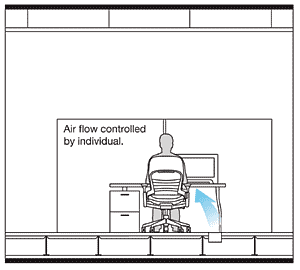Raised Access Floors: The Foundation of Flexibility and Efficiency
Within that framework, access floors have the potential to contribute to the following LEED-NC points:
Materials and Resources (MR)
13 total possible points; up to four points applicable to
access floors:
- MR 4.1 ~ 4.2 25 or 50 percent Recycled Content of Materials
1-2 points
−Total weighted recycled content versus costs. - MR 5.1 Manufactured Locally within 500 miles 1 point
- MR 5.2 Mfg. locally with Regional Materials (500 miles) 1 point
Indoor Environmental Quality (EQ)
15 total possible points; up to nine points applicable to
access floors
- EQ 2 ~ Increased Ventilation Effectiveness (air-changes) 1 point
- EQ 3.1 ~ Indoor Air Quality Plan during construction 1 point
- EQ 3.2 - Indoor Air Quality Plan before occupancy 1point
- EQ 4.1 to 4.4 ~ Low Voss paints/adhesives/carpet/wood 1-4 points
- EQ 6.2 ~ Individual Controls temperature/lighting 1 point
- EQ 7.1 and 7.2 − Thermal Comfort per ASHRAE 55 1 point
Innovation in Design (ID)
Five total possible points.
- ID 1.1 to 1.4 ~ Innovation in Design 1-4 points
2. LEED-EB: The LEED Green Building Rating System for Existing Buildings (LEED-EB) is a set of performance standards for the sustainable operation of existing buildings. The LEED-EB criteria cover building operations and systems upgrades in existing buildings where the majority of interior or exterior surfaces remain unchanged. LEED-EB maximizes operational efficiency while minimizing environmental impacts. It provides a recognized, performance-based benchmark for building owners and operators to measure operations, improvements, and maintenance on a consistent scale. It is a road map for delivering economically profitable, environmentally responsible, healthy, and productive places to live and work, by addressing the following:
- Whole-building cleaning and maintenance issues including chemical use
- Ongoing indoor air quality (IAQ)
- Energy efficiency
- Water efficiency
- Recycling programs and facilities
- Exterior maintenance programs, and
- Systems upgrades to meet green building energy, water, IAQ, and lighting performance standards
LEED-EB is based on a total of85 points with award levels as follows:
| Certified | 32 to 39 points |
| Silver | 40 to 47 points |
| Gold | 48 to 63 points |
| Platinum | 64 or more points |
Within this framework for existing buildings, access floors have the potential to contribute to the following LEED-EB points: Figure 10-Personal Control
|










